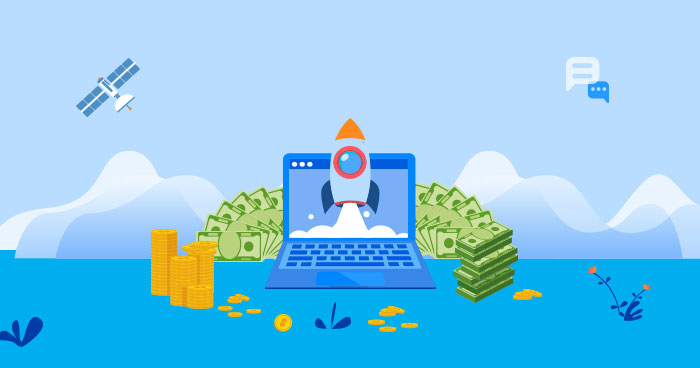
A startup demands much more than just a great idea. It demands a lot of time, discipline, dedication, and most importantly, funding. A 2016 British Business Bank Survey highlights the fact that more than 60% of startups require external funding rounds in order to establish their ground firmly. Hence, without further ado, let’s discuss the various startup funding stages that every entrepreneur should know.
Managed Cloud Hosting for Your Startup | Starts at $11
Focus on growing your business without the stress of managing website operations.
The startup funding rounds have transformed the business landscape completely, over the past few years. Not long ago, the available startup fundraising options were few, but lately, we’ve experienced a surge for startup funding at different stages. As a budding startup owner, you must evaluate where your startup stands and how much funding can you raise from external sources.
Before we discuss ins and outs of each funding stage, here’s an overview of major startup funding stages.

Now let’s delve deeper into different stages of fundraising in a startup lifecycle.
1. The Pre-seed Funding Stage
This prime stage of seed funding falls so early that it’s not even considered as a startup funding. The pre-seed funding stage generally refers to the time period in which a startup is getting their operations off the ground.
It’s likely that investors won’t make an investment in exchange for equity in the startup during the pre-series stage. This stage can last for a long time or you can get pre-series funding in quick time. It depends on the nature of your startup and the initial costs that you must consider while developing the business model.
However, you can explore other financing options such as crowdfunding or angel investors, and also consider using platforms like Sourcescrub to identify potential investors and connect with them. Alternatively, you can also explore other Sourcescrub alternatives to find the right investors for your startup.
The pre-seed funding stage is commonly known as bootstrapping. In simple terms, it means using your own existing resources in order to scale your startup. Startup owners invest from their own pocket and try to grow themselves in the most resourceful manner.
During the development stage of the startup, entrepreneurs may have to work overtime or get a second job so that they can invest their additional income into their new startup.
Let’s learn about pre-seed funding from Jonathan Mills Patrick of Funding Simplified:
Adding to what Jonathan said, the pre-seed funding stage allows a budding startup to build and distribute their product(s) or service(s) effectively. In the research or development phase, the entrepreneurs tend to assess the viability of their idea. They might have a working prototype of their product and are in search of appropriate funding that allows them to scale their startup full-time.
During this stage, many entrepreneurs also seek guidance from founders who have been there and have gone through a similar experience as them. It allows them to determine the incurring costs of their idea or project, develop a winning business model, and garner ideas on how to grow their plan into an operating business.
Entrepreneurs should also work out any necessary partnership agreements, copyrights, or other legal issues during the pre-series stage as similar issues are best resolved during this stage. Later on, they might become expensive and even insurmountable. Also, no investor will provide funds to a startup having legal issues prior to their launch.
Give Your Startup the Cloudways Edge
With super fast and reliable managed hosting platform you can grow your startup the way you want.
Potential Investors of Pre-Seed Stage
The most common pre-series investors are:
- Startup Owners
- Friends and Family
- Early Stage Venture Funds (Micro VCs)
“Ask people who know you already. Friends, past co-workers, family, etc. That is your best and almost only chance. Failing that ask people who are from the industry and have a lot of money. They might be able to recognize something at the pre-seed stage.” said Kamal Hassan, Partner at Loyal VC.
According to Max Benz Founder at girokonto “Bootstrapping a business can be incredibly difficult, especially during the pre-seed funding stage. Entrepreneurs may have to exhaust their finances and even take on extra jobs in order to fund their businesses. It requires tremendous dedication and effort, as success is not guaranteed and there are many risk factors to consider when investing your own resources into a startup. However, if done correctly, bootstrapping can provide benefits that traditional investments do not, such as allowing entrepreneurs to retain control over their business while also potentially achieving greater returns on investment in the long run.”
Startup Valuation in Pre-Seed Stage
During the pre-seed funding stage, startups value anywhere between $10,000 to $100,000.
Active Pre-Seed Stage Funds
2. Seed Funding Stage
After the pre-seeding stage, it’s time to actually plant the seed. The first in the startup funding stages is “Seed funding”. Almost 29 percent of startups fail because they run out of capital while bootstrapping, which makes seed capital critical to get a business up and running.
Entrepreneur turned investor, Mark Suster says: “The single biggest mistake founders make is waiting until they have too little cash in the bank before fund raising”
You can consider the seed funding stage as an analogy of planting a tree. Ideally, the initial funding is the “seed” which allows any startup to flourish. When you provide appropriate water i.e. a successful business strategy, alongside the dedication of the entrepreneur, the startup will eventually grow into a “tree”.
Because the investors are taking a huge risk by investing in the business, startups must provide them equity against seed fundings. The stakes are even higher because, at this stage, startups cannot guarantee a successful business model.
Seed funding allows a startup to fund costs of product launch, get early traction through marketing, initiate important hiring and further market research for developing product-market-fit.
Many startups consider the seed funding round is all that is necessary to successfully get their startup off the ground.
Potential Investors of Seed Stage
The common types of investors who participate in seed funding are:
- Friends and Family
- Angel Investors
- Early Stage Venture Funds (Micro VCs)
- Crowdfunding
Startup Valuation & Fundraising in Seed Stage
Startups that are eligible for seed funding have a business that values anywhere between $3 million to $6 million. The seed funding stage will facilitate funding from $50,000 up to $3 million for a promising startup.
Active Seed Stage Funds

Learn All About Funding from Experts by Joining the Best Communities.
Enter email to download the list of 100+ Communities.
Thank You
Your List is on it’s Way to Your Inbox.
3. Series A Funding Stage
Series A stage is the first round of venture capital financing.
By now, the startup must have a developed product and a customer base with consistent revenue flow. Now it’s time for them to opt for series A funding and optimize their value offerings. This is an ideal opportunity that allows startups to scale themselves across different markets.
In the Series A funding round, it’s significant to have a plan that will generate long-term profits. Many times, startups come up with great ideas that can generate a substantial amount of enthusiastic users, however, they do not know how to monetize it in the long run.
This is the stage where you must start learning how fundraising works and start making early connections with angel investors and VCs. Following the 30-10-2 rule, you must identify investors who would want to invest in your startup. According to this rule, you must find 30 investors who are willing to invest in your business. 10 out of those 30 investors might show interest in your proposal, 2 of which will really pass on funds to you.
Mark Suster said, “Meet your potential investors early. Tell them you’re not raising money yet but that you will be in the next 6 months or so. Tell them you really like them so you want them to have an early view (which is what all investors want).”
Series A funding mostly comes from angel investors and traditional venture capital firms. They are not looking for “great ideas”, instead, they are looking for startups with a solid business strategy that can turn their great idea into a successful, money-making organization, allowing the investors to reap the benefits of their investment.
A single investor may serve as an “anchor” but once a startup has secured its first investor, it’s easier to attract additional investors. Although angel investors prefer to invest during this stage, they tend to have much less influence than VC firms in this stage.
Potential Investors for Series A
- Accelerators
- Super Angel Investors
- Venture Capitalists
Company Valuation & Fundraising in Series A
Startups with a good business plan valuing up to $10 million to $30 million are able to raise approximately $15 million during the Series A funding stage.
Active Series A Investors
4. Series B Funding Stage
Startups that go through the previous startup funding stages (seed funding and Series A) have already developed a substantial user base alongside a steady stream of revenue. They have proven themselves in front of their investors that they are can achieve success at a larger scale.
Investors assist startups to expand their horizons by funding their market reach activities, increasing their market share, form operational teams such as marketing, business development, and customer success. The series B funding stage allows startups to grow so that they can meet the various demands of their customers and also compete in tight markets in terms of competition.
Series B funding stage may appear to be similar to the former funding stage in terms of processes and key players, however, series B funding is often led by same characters, including a key anchor investor that helps you to attract other investors. The major difference is the addition of a new wave of VCs that specialize in investing in well-established startups so that they can further exceed expectations.
“The dilemma is that while your Series A investors were extremely important to you during that round, they may not be the investors you need going forward. If you are in a position where going public is a real possibility, then you need the crossover investors who will be there for you today and when you go public,” suggests Praveen Tipirneni, MD & CEO of Morphic Therapeutic Inc.
Potential Investors for Series B
- Venture Capitalists
- Late stage VCs
Company Valuation & Fundraising in Series B
Startups with a revenue-generating model, valuing up to $30 million to $60 million are able to raise approximately $30 million during the Series B funding stage.
Active Series B Investors
5. Series C Funding Stage
Startups that make it to the series C funding stage should be on their growth path. These startups search for more funding that could help them build new products, reach new markets, even acquire other under-performing startups of the similar industry.
In the series C funding stage, investors happily fund successful startups. They are hopeful to receive a profit that is more than the money they invest. The Series C funding stage focuses on scaling the startup as rapidly as possible.
To scale your startup significantly, you can acquire different startups with the Series C funding. By now, your startup operations have become less risky whereas more investors are coming in to play. Many hedge funds, investment banks, private equity firms etc. will happily invest in your startup during the Series C stage.
The reason behind this is that the startup has already proven itself to be an operating success. New investors join the game by investing a significant amount of money into thriving startups to secure their own position as leading investors.
Do remember that startups that engage in Series C Funding are well-established, hold a strong customer base, have procured stable revenue streams alongside proven histories of their growth, and want to expand their operations on a global scale. If you haven’t accomplished any of the above, then you’re not ready for the Series C funding yet.
“Now is a better time than ever for emerging businesses to apply for the funding they need to accelerate their growth,” said Marz Ayyad, EMEA Lead at NetSuite PE & VC Practice.
Potential Investors for Series C
- Late stage VCs
- Private Equity Firms
- Hedge Funds
- Banks
Company Valuation & Fundraising in Series C
Startups with a good business growth valuing up to $100 million to $120 million are able to raise approximately $50 million during the Series C funding stage.
6. Series D Funding Stage and Beyond
Not many startups find a need to go to this stage. The Series D funding stage allows entrepreneurs to raise funds for a special situation. For instance, a merger and also if it has not yet hit its growth goal.
A startup may consider series D funding if it hasn’t gone public yet, but is contemplating a merger with a competitor on agreeable terms. The Series D funding offers startups the most viable solutions allowing them to negotiate issues head-on by acquiring another startup as a merger.
Also, If a startup was unable to achieve its growth landmark with series C funds, then it will find a need to get more funds through series D funding to keep afloat.
Potential Investors for Series D
- Late stage VCs
- Private Equity Firms
- Hedge Funds
- Banks
Company Valuation & Fundraising in Series D
Startups in this stage may value around $150 million to $300 million are able to raise approximately $100 million during this startup funding stage.
Active Series C & D Investors
7. Initial Public Offering (IPO)
IPO is the process of offering corporate shares to the general public for the first time.
Growing startups that need funding often use this process to generate funds, whereas established organizations use it to allow startup owners to exit some or all of their ownership by selling the shares to the general public.
When a startup decides to go public, a specific set of events occur during the IPO process. They include:
- Formation of an external public offering team comprising of underwriters, lawyers, certified public accountants, and SEC experts.
- Compilation of the startup’s Information including its financial performance as well as its expected future operations.
- Audit of the startup’s financial statements takes place which generates an opinion about its public offering.
- The startup files its prospectus with the SEC and determines a specific date for going public.
Benefits of IPO
Raising funds for the startup is not the only benefit that entrepreneurs enjoy in case of a public offering. Some other advantages are:
- A public organization is able to generate additional funds through secondary offerings as it already has access to public markets.
- Many public organizations compensate executives through stock. The stocks of a public organization are more attractive to employees as the stocks can be sold easily. Also, being public allows an organization to recruit better talent as well.
- Mergers are easier for a public organization as it can utilize its public shares to acquire another startup.
In a nutshell
The various startup funding stages allow entrepreneurs to scale their startup at any stage of their entrepreneurial journey. This scaling practice allows them to identify where their startup stands and which potential investors would invest in them in order to help them grow.
Do remember that in order to gain funding, startups must be mature enough to qualify for a specific funding round. You can identify where your startup stands by its net worth.
Many startup owners retire once after they’ve gone public. Many amongst them also prefer becoming an angel investor themselves and invest their hard earned money into other startups. After all, they’ve certainly earned the right to relax and advise other entrepreneurs on how to grow their startup and make it profitable.
Sameer Dholakia, SendGrid CEO has said, “I think the biggest benefit is our increased brand visibility, which is helpful in attracting both new customers and teammates.”
Frequently Asked Questions
Related Article:
How to Get Startup Funding For Kick-starting Your Business
Startup Pitch Deck 101: How To Create a Winning Pitch Deck For Startup
Arsalan Sajid
Arsalan, a Digital Marketer by profession, works as a Startups and Digital Agencies Community Manager at Cloudways. He loves all things entrepreneurial and wakes up every day with the desire to enable the dreams of aspiring entrepreneurs through his work!


